ROI
State of B2B Tech Content Marketing: 5 Trends That’ll Get You Promoted
B2B companies always have to think a step ahead. They’re looking for something that’ll give their products and services an extra edge. Something that’ll convince potential customers to learn more. Great content marketing has the power to do that.
Today’s audiences come across so much mediocre content that looks and sounds the same. Lately, innovative marketing teams have been thinking beyond the standard blog post. They’re investing in new formats and new ideas that can push their businesses forward.
In our brand new report, we set out to highlight tactics that could help your brand thrive. We analyzed the entire B2B content marketing landscape, talked to experts, and broke down case studies from companies like Google, Microsoft, HubSpot, and more.
Here are the five biggest trends you need to know.
[If you prefer to view a PDF version of the report that’s easier to print, we’ve got you covered here.]
1. Interactive Tools Give Brands a Creative Edge—and Empower Buyers
On Google, there are 260 million search results for “b2b technology.” There are only 214 million for “b2b software.” Based on the numbers, you’d expect b2b technology to be the more popular term. But according to Google Trends, that’s not the case. For most of 2020, b2b software has had about twice as much interest.
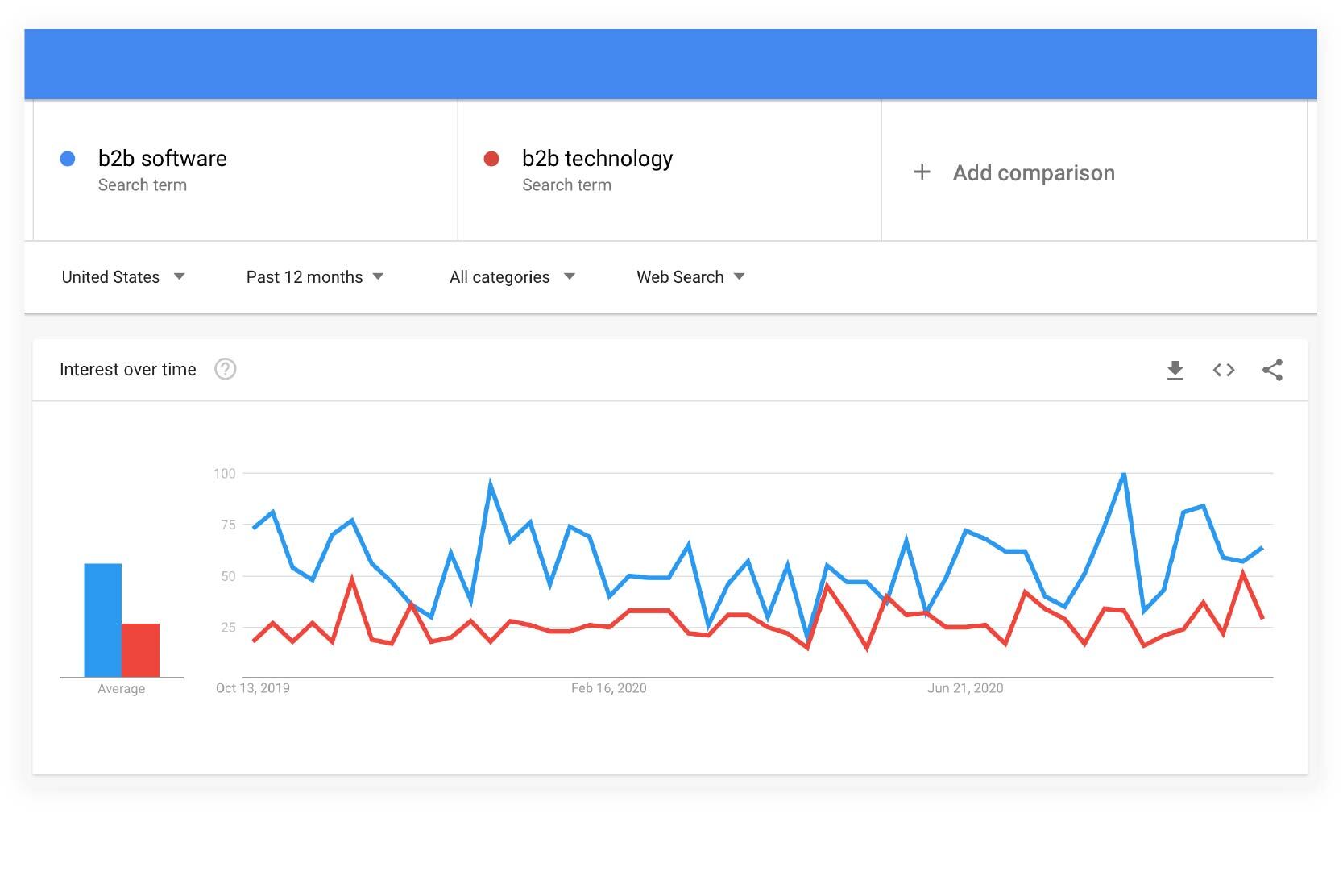
Data like that is powerful evidence for B2B marketers who can optimize their sites to take advantage of a keyword inefficiency. Best of all, anyone can access that information, and more just like it. Want to test your site speed? Assess your marketing maturity? Identify untapped markets? You can investigate all of these questions yourself using the Digital Marketing Toolbox on Think With Google.
A few years ago, the search giant launched Think With Google, a content hub for marketers and business owners. “It’s intended to be a resource for everything from high-level insights to deck-ready stats to useful tools,” said Alli Mooney, the site’s former editor-in-chief, who now runs brand content at Waze.
Those types of tools are just as useful for Google’s marketing team as they are for its audience. Interactive tools are one of the most cost-efficient content investments you can make because of their evergreen appeal. And once the content is live, it won’t require much upkeep.
A few good examples of this include CoSchedule’s Headline Analyzer and Canva’s Color Palette Generator. Both tools occupy top spots on search rankings, driving more long-term value than your average blog post. According to a study by Demand Gen Report, interactive content was more effective at educating buyers than static content by 23 percentage points.

It’s the difference between telling someone what to do and empowering them to find the answer on their own. Why give a man a fish when you can teach him to how to benefit from your B2B software, right?
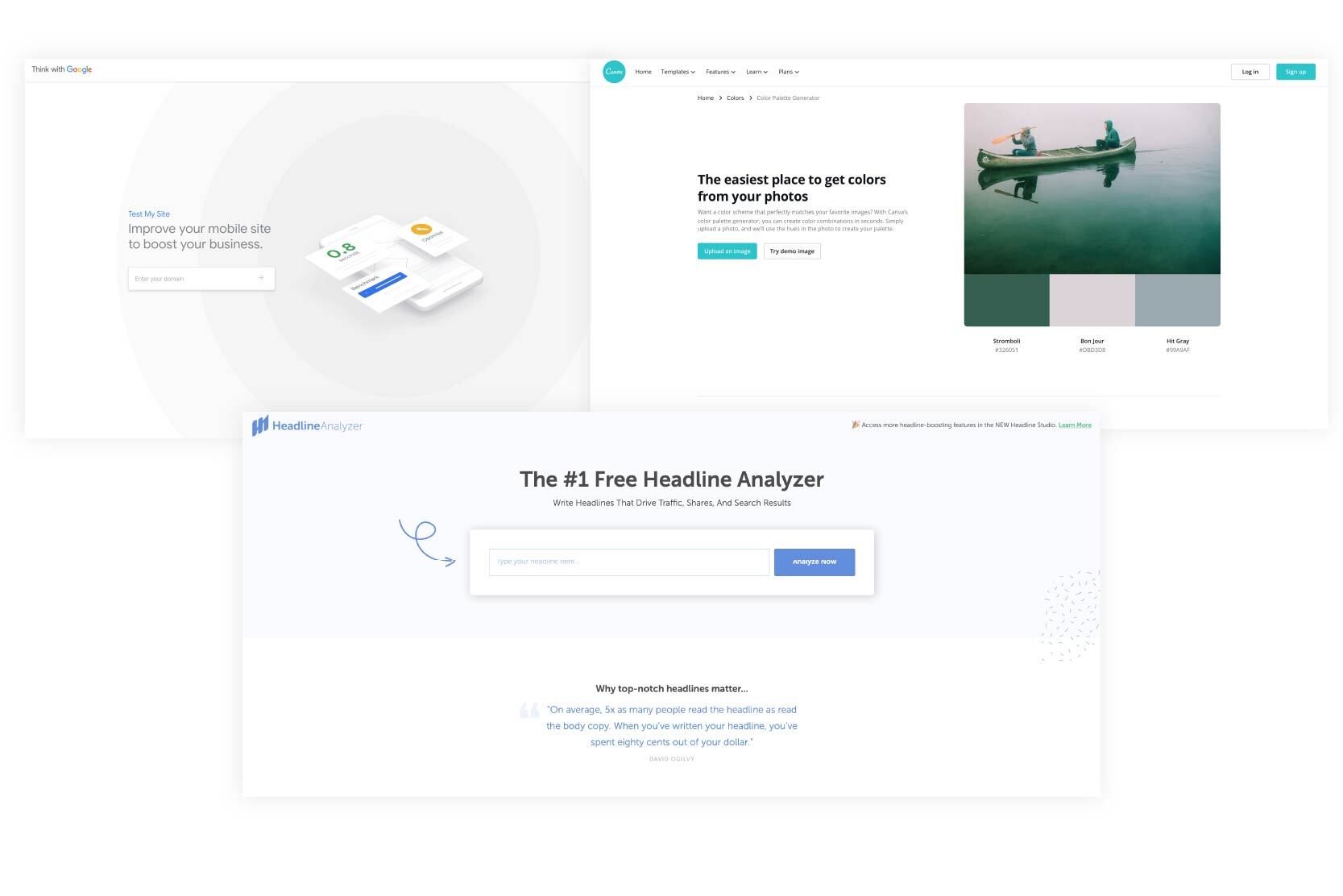
“When you let your customers interact with your content, they make choices that are relevant to them, and you learn more about them each time they click,” said Jennifer Burak, who was VP of marketing for Rapt Media, an enterprise video platform, before becoming director of marketing at Techstars. “This helps you create better content and continue to optimize your existing content.”
Interactive content encompasses a variety of formats like videos, calculators, quizzes, and even games. Creating this kind of B2B content can sound complicated if you’ve never done it before, but there are simple ways to get off the ground: calculators and quizzes.
Calculators have become the go-to resource for a lot of companies because they let people consider costs without a hard sell. Salesforce, for example, has a free ROI calculator that promises to show “how revenue, gross margin, and cost control could improve.” To make it as easy as possible, Salesforce asks users to filter by industry, which automatically enters some data based on recent benchmarks.
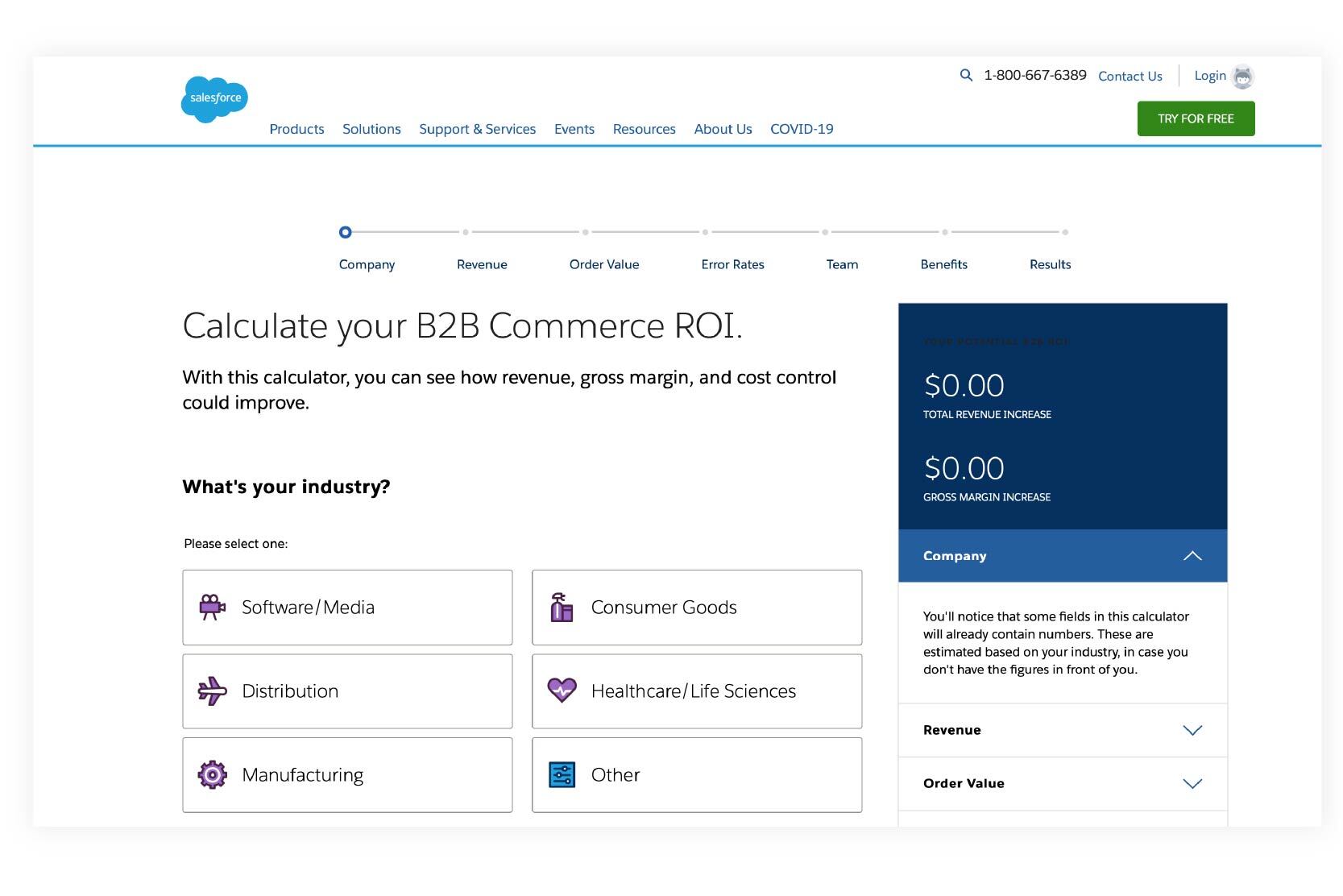
You can see why a tool like this is beneficial. It makes the case for why you’ll benefit from buying Salesforce, without you ever having to talk to a salesperson.
BuzzFeed’s calling card—quizzes—also works for B2B companies. Only instead of asking people to choose from 13 pictures of Taylor Swift and telling them what kind of dog they are, B2B marketers can develop diagnostic quizzes that point users toward solutions for their biggest work challenges. At Contently, we added a Content Strategy Assessment at the bottom of our content strategy services page on our website to help potential customers evaluate which of our solutions fits their needs.
When done right, interactive tools don’t just drive leads. They qualify them too, providing key information that’ll help you personalize your follow-up and push prospects down the funnel more efficiently.
For marketers wondering how to build awareness and even drive leads, this is one easy way to get people interested in your company. Tools like Typeform, Calconic, and Qzzr offer free trials and have plans for about $30 per month.
We expect brands to test the waters with more tools in the near future. And if that goes well, then they can graduate to our next trend.
How to take advantage of this trend:
- Do some research in your field to see what tools already exist and where you can stand out.
- Start simple with a calculator or outcome quiz that your audience can use to discover something about themselves.
- Add value by guiding the user toward a solution like a relevant resource, case study, or product page.
2. Educational Courses Are Lead Gen Machines
Way back in 2011, some employees at HubSpot had an idea. They wanted to create an educational program on inbound marketing for HubSpot customers. So they wrote scripts for a few lessons, shot a few videos, and published them on a landing page. At the end of the course, they included an optional exam. If someone went through the course and passed the exam, they’d receive an official Inbound Certification.
“At the time, we knew it wasn’t the best course on SEO or content marketing or email marketing,” the company wrote in a recent e-book. “But what [the] Inbound Marketing [course] did do well was combine all of those strategies into a framework that really spoke to SMB marketers.”
Almost a decade later, that single project has evolved into HubSpot Academy, which offers over 350 free online courses. Per HubSpot, the Academy educates “tens of thousands of users every month.” In Q1 of 2020, new leads increased 115 percent year-over-year. Anyone can access the database to get certified in disciplines ranging from content marketing to business analytics to e-commerce. All you have to do is fill out a form.
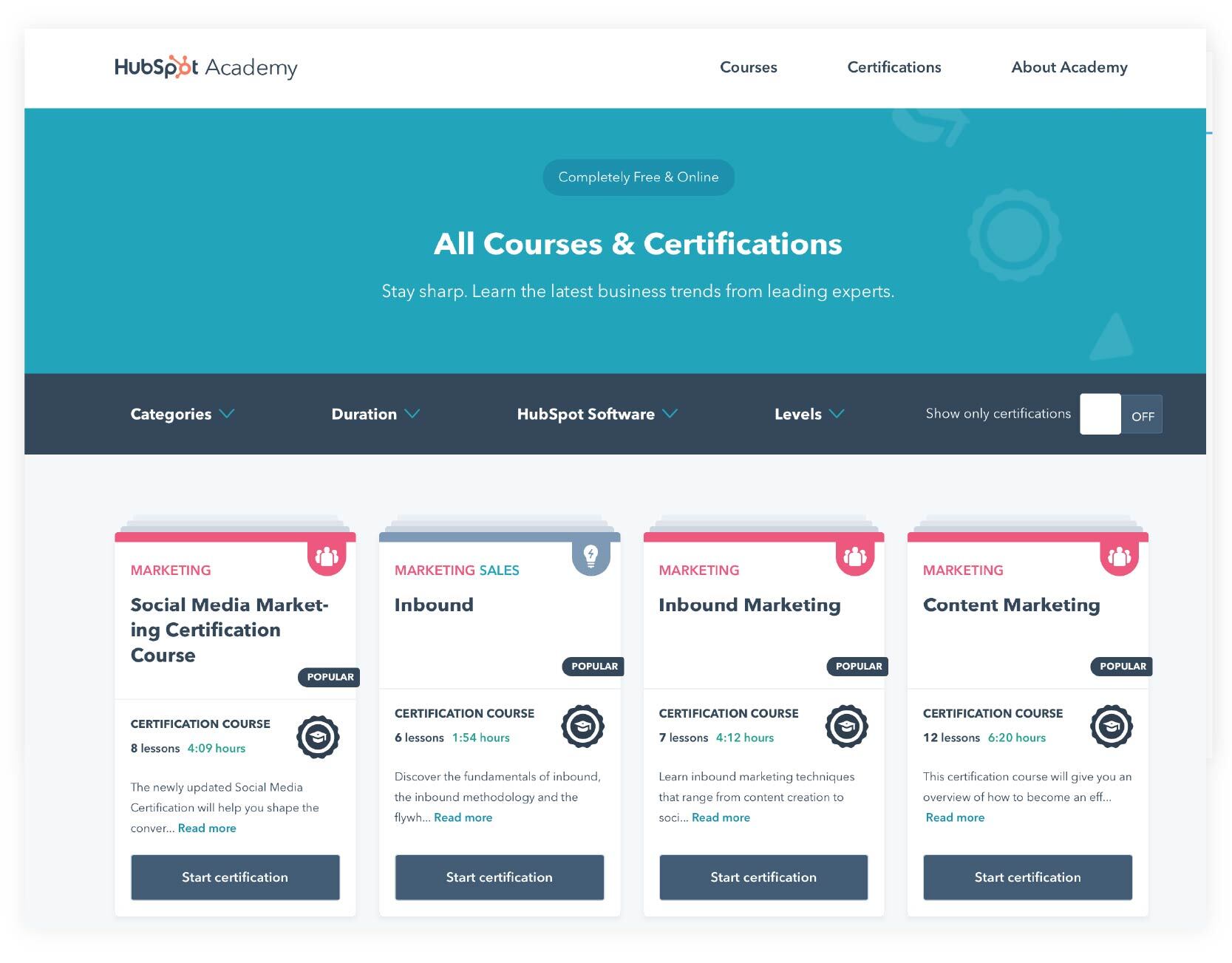
HubSpot was clearly onto something. Virtual learning has boomed in recent years thanks to massive open online courses (MOOCs) like Coursera. Students can go through the material at their own pace, usually for free. Even esteemed colleges like Harvard and Yale have gotten in on the action, letting the public take certain online classes without needing to pay a cent of the $50,000 tuition.
In the professional world, this trend has huge appeal, especially for B2B companies. Workers can add to their skillset or learn something new if they want to switch careers. B2B marketers, meanwhile, can break down their complex products and services into lessons that are easy to understand. The courses also help nurture leads gradually (and improve customer retention). The built-in structure gives people a reason to come back multiple times to finish the lessons on your site.
Every course begins with a landing page. Think of it as a syllabus or outline, packaging the different components. This typically reveals how many lessons there are, who’s teaching them, and how long it’ll take to complete the whole course.
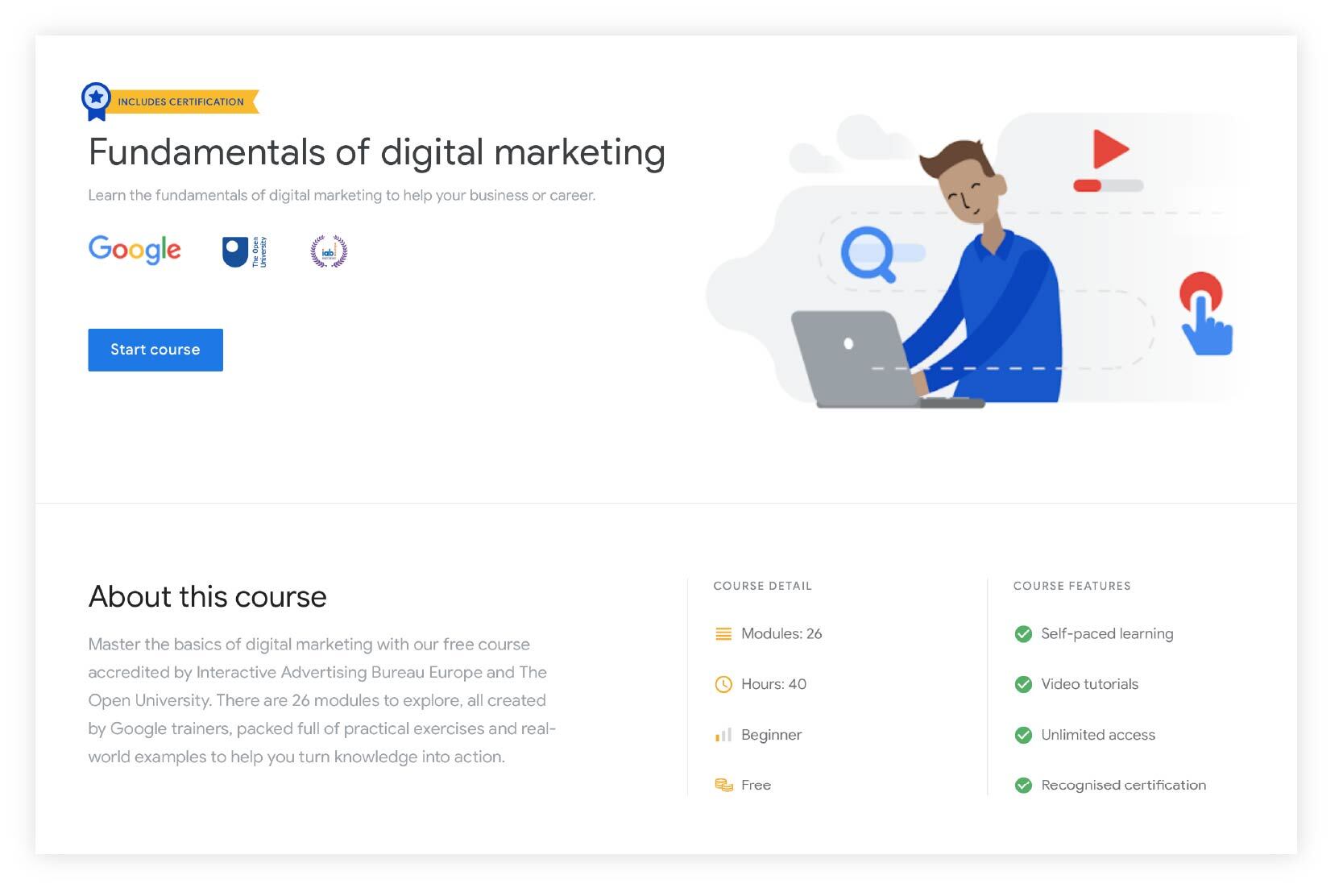
One reason these courses are so popular is because of chunking. The term comes from Harvard psychologist George A. Miller, who, in the 1950s, found that humans tend to memorize information best when something is split up between five and nine segments. If your boss asks you to learn Google Analytics, that sounds daunting. But if you go to Google Analytics Academy and see there’s a beginner course with smaller units for setting up basic campaigns and tracking conversions, suddenly the request seems more manageable.
For marketers, chunking supplies an added bonus: It gives users a clear reason to fill out a lead form. We’re all bombarded with pop-ups asking us to subscribe to newsletters and talk to a salesperson. But it makes sense to give up your email when you’re taking a course so that new lessons can be delivered to you on time.
Most successful courses incorporate video lessons, but you don’t need a huge budget (or an academy) to put together a successful video course. The key ingredient is knowing what your audience wants.
In 2014, three researchers from MIT, edX, and the University of Rochester studied 128,000 students learning through MOOCs. The goal was to find virtual learning trends and provide recommendations for instructional designers and video producers.
After evaluating over 6.9 million watching sessions, here’s what the researchers suggest:
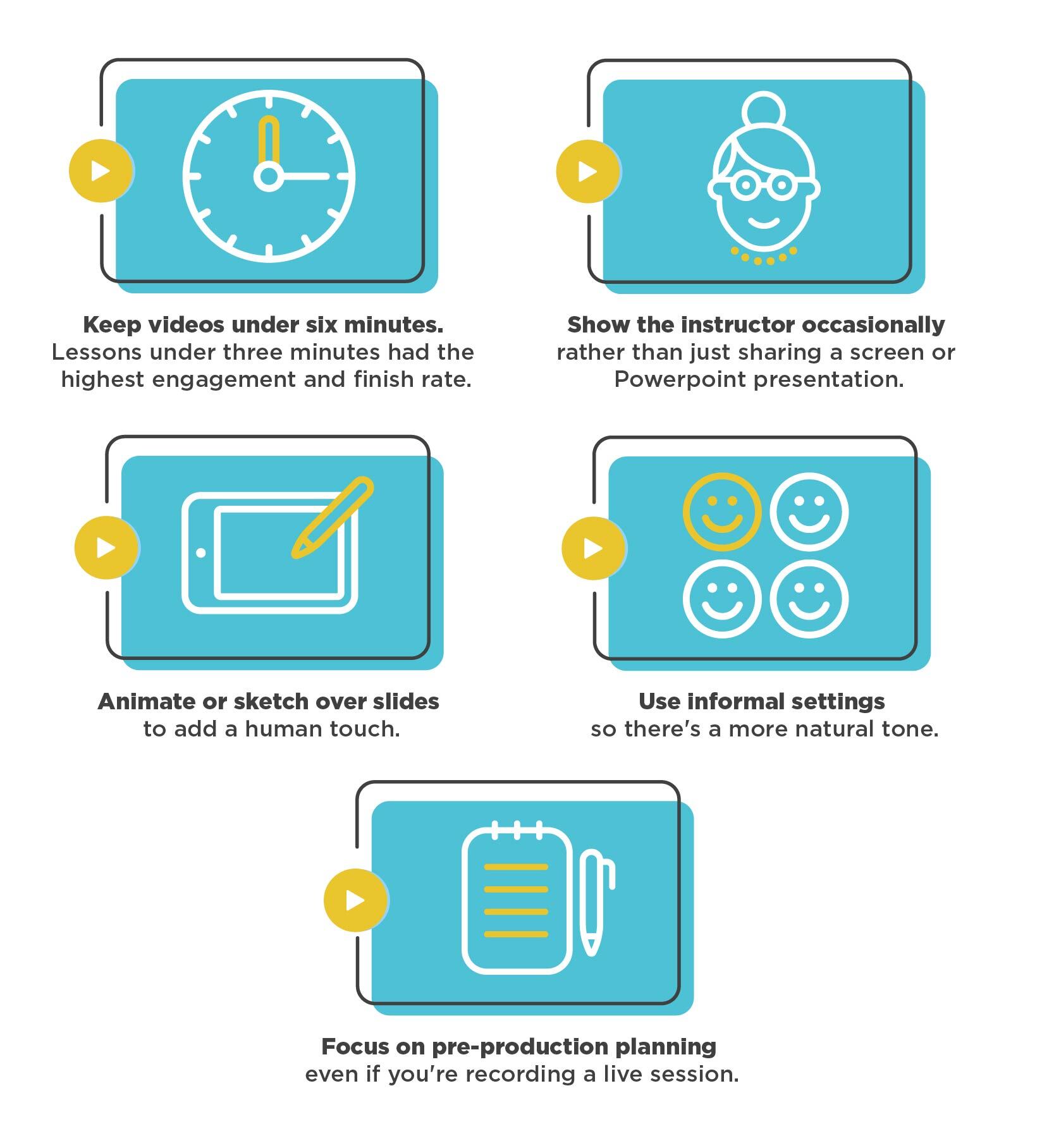
B2B marketers, particularly in tech, already have the instincts to build a course like this, since they’re used to communicating with a digital audience.
“Presentation styles that have worked well for centuries in traditional in-person lectures do not necessarily make for effective online educational videos,” the researchers wrote. “To maximize student engagement, instructors must plan their lessons specifically for an online video format.”
How to take advantage of this trend:
- Review your existing content to find common themes or topics that could become courses.
- Use your content calendar to map out new course lessons well ahead of time if you’re starting from scratch.
- Keep video lessons short and highlight the instructor to give the course a personal connection.
3. Newsletters Have Become the Centerpiece of Content Distribution and Audience Building
There’s always another hot new marketing channel. Snapchat, TikTok, Instagram, Alexa have all been anointed the next big thing that marketers need to care about. But one of the greatest resources marketers have at their disposal has barely changed in 50 years: email.
As organic social media traffic tailed off last decade and mobile device usage made homepages less essential, email newsletters helped marketers direct readers back to their sites on a regular basis. In a way, the inbox is now the new homepage. And it’s no longer a channel that brands can ignore.
Platforms like Substack have made it ridiculously easy for anyone to start an email newsletter. The appetite is there for this kind of content. It’s gotten to the point where people from places like Digiday and Politico are leaving their full-time jobs to start subscription newsletters.
For marketers, it’s also a more personal alternative than social media. As journalist Casey Newton told The New York Times, “You don’t have to fight an algorithm to reach your audience.” That’s why brands and publishers alike have opted for more personality in their messages, even letting certain employees include their names in corporate emails. I have a last name, but you may know me as Jordan at Contently. I’ve also come across Taco at Trello, Sophia at Yesware, and even Charles the Dog at Lighthouse Creative.
This personality has a point. Per HubSpot, 78 percent of marketers noticed an increase in email engagement over the last year. And according to Content Marketing Institute’s 2020 B2B Benchmarking Report, marketers rated email newsletters as the best way to nurture leads, ahead of blog posts, in-person events, and case studies.
“We love email,” GE’s Chief Storyteller told us. “It may sound old-school, but email subscription is really a hardwired link to your audience. For us, email subscribers are an extremely valuable audience that we want.”
A big part of email’s value comes from having a reliable connection with your audience. You can link to B2B content on social channels, but you’ll have to pay for distribution for it to have a meaningful impact. (Organic reach on Facebook was clocked at just 5 percent in April 2020.)
It’s like building a house on somebody else’s land. As our head of marketing Joe Lazauskas wrote in his guide to compounding content ROI: “Spend $500 on ads today, and you’ll have to spend again tomorrow to see the same results. But spend $500 on a piece of great content today and it will drive continuous traffic and leads for free—by ranking well for search, engaging website visitors, and increasing newsletter engagement.”
At Contently, we developed a model to map out how our newsletter impacts the bottom line. Our blog, The Content Strategist, gets hundreds of thousands of unique visitors each month.
For the people who aren’t already subscribed to our newsletter, we put a pop-up on our site that lets them sign up if they’re interested. That pop-up converts at 2 percent. That means that every 100,000 new visitors will yield 2,000 new email subscribers.
Of those 2,000 new email subscribers, about 2 percent will request a demo of Contently over the next couple of quarters.Based on the average value conversion rates of an MQL, those 40 demo requests are worth $200,000 in weighted pipeline to our business.
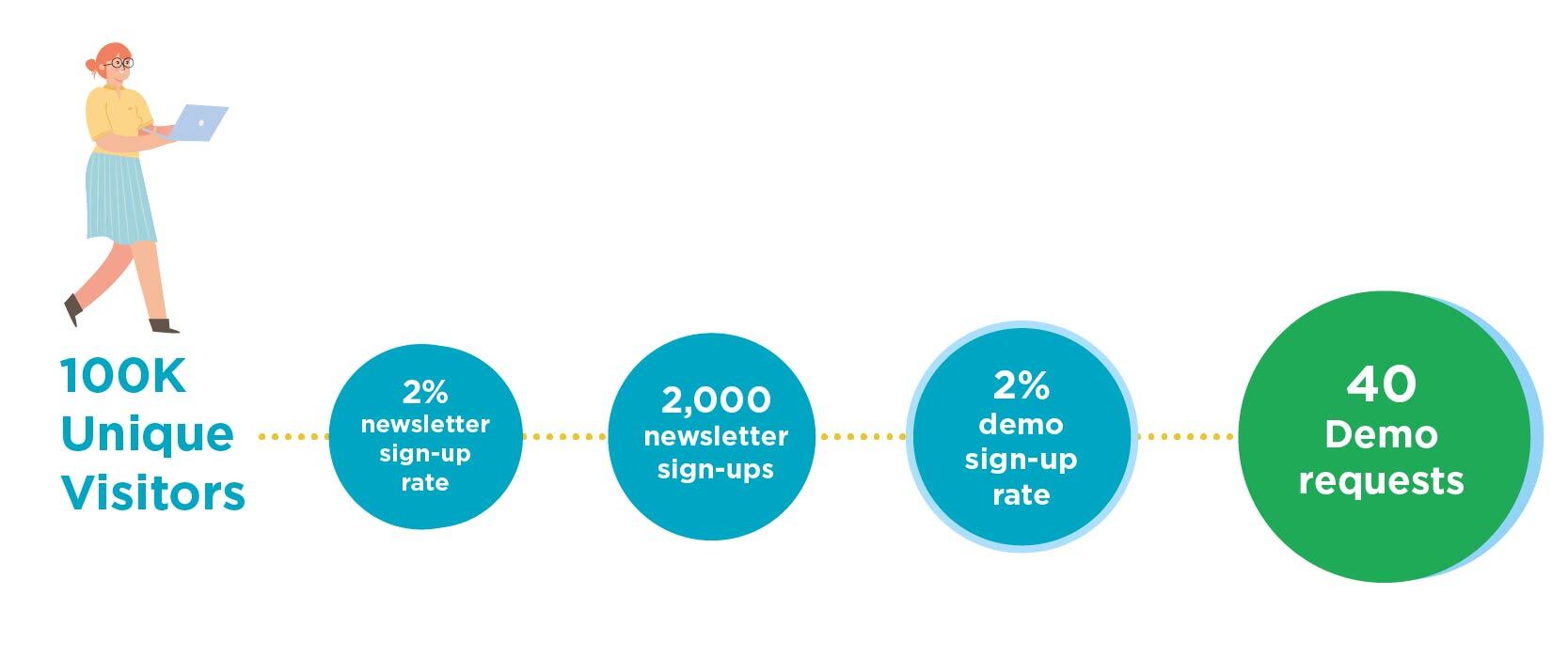
Additionally, email provides more freedom to customize and experiment compared to other content distribution channels. Marketers have the ability to segment their subscriber lists. This tactic can be really useful if you’re trying to reach people in different industries, roles, locations, and more. Urbansitter, a tech company that connects parents and babysitters, increased conversions by 260 percent just by segmenting emails to its two different user groups.
Sending a newsletter isn’t exactly a new trend. But what’s noteworthy is that companies are beginning to treat email as one of the most important parts of the content lifecycle. It can be the ultimate factor that makes or breaks a B2B content program.
If you’re new to content marketing, look for ways to build your list and feed subscribers with insightful material. Even if the material doesn’t come from you all the time. Email partnerships, content swaps, and content curation can all get you in front of new people.
Morning Brew, which publishes four newsletters including Marketing Brew, has executed this strategy to perfection. The company expects to earn $20 million in ad revenue by the end of 2020, per Digiday. It has over 2 million subscribers across the newsletters and boasts an incredible 42 percent open rate.
Those numbers may seem untouchable right now, but keep in mind that Morning Brew had 160,000 subscribers two years ago. Email growth can happen fast, as long as you send the right message.
How to take advantage of this trend:
- Set up lead forms on your site so it’s easy for people to subscribe to your newsletter.
- Give employees the freedom to have personality and share their experiences.
- Segment your subscriber list over time so you can tailor content to different audience personas.
4. B2B Tech Leaders Are Reimagining the Product Story in New, Creative Ways
88 Acres: How Microsoft Quietly Built the City of the Future…
It reads like the title of an award-winning magazine feature. Should’ve been, really. In 2014, Microsoft pitched a bunch of journalists an idea about how a group of employees were analyzing sensory data to revolutionize the way the company used energy across its 500-acre campus.
All of them passed. So Microsoft’s communications team decided to cover it themselves. Jennifer Warnick, the lead writer of Microsoft Story Labs at the time, put the article together. Forty-eight hours after it went live, 800,000 people had read it. To this day, it’s arguably one of the best pieces of content marketing ever created.

“88 Acres” is the platonic ideal of a product story. A Microsoft employee wrote about other people at Microsoft using the company’s products, and it didn’t come across as self-promotional.
When companies write about themselves, we usually wind up with dry, hollow press releases. However, the typical press release machine has become somewhat outdated. Why put an update on the wire hoping a journalist covers it when you can tell your audience directly? Microsoft’s story shows what happens when a brand controls its own narrative.
Over the years, brands have gradually warmed up to the idea. SEMrush uses its own features to analyze its content on a regular basis. Then there’s Typeform, which walked us through a more unusual example earlier this year. When Paul Campillo, head of brand and communications, was working on a story about chatbots, he wanted to insert one so readers could ask it questions about the article. Only problem was, Typeform didn’t have a chatbot. So their dev team built one.
“The article was a huge success,” Campillo said. “Now it’s one of Typeform’s three offerings.”
Marketers have this tendency to sugarcoat everything. But we’ve heard from clients that they liked learning about our trials and errors. They could relate to our challenges and follow each step as we worked to overcome them. At Contently, we think of ourselves as our best case study.
That’s something anyone can do, regardless of whether or not they have a tale as rich as “88 Acres.” And since product stories appeal to both new leads and existing customers, the content can help with onboarding and retention. Think of them like Help Center assets that customers can use to solve problems on their own—only with more creativity than the usual instruction manual approach.
For software companies, these stories can be integrated throughout the product. We’ve started doing this ourselves with a new video series called “Contently In Action.”
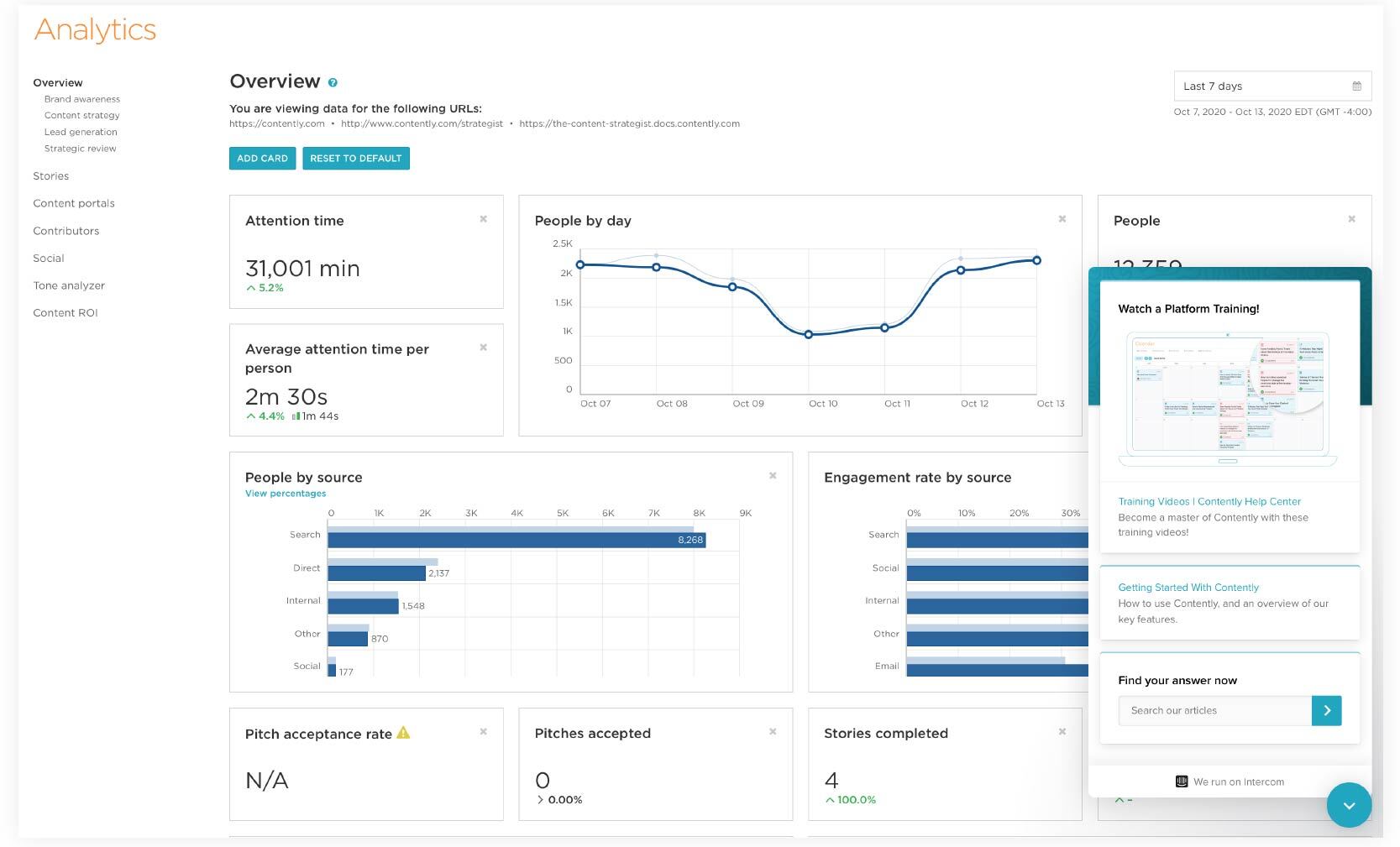
When customers reach a certain part of our platform, a short tutorial pops up and explains how we use the feature to optimize results. It may not win an Emmy, but it serves actionable advice at the right time.
How to take advantage of this trend:
- Compare a press release and an article side by side while noting the differences in tone and creativity
- Sort through the most popular Help Center articles or tutorials to discover good product story ideas
- Write about your own experiences using your product like an investigate reporter, highlighting challenges and solutions
5. Branded Shows Are the Future of Multimedia Content
The average Netflix subscriber spends two hours per day on the streaming service. When marketers publish content, they’re usually hoping someone will spare two minutes to look at it.
That’s such a stark difference when you say it out loud. At the core, though, a Netflix executive and a B2B marketing executive are after the same thing. Both are building audiences and vying for user attention to increase revenue. So how can we get people as vested in our B2B content as they are in Stranger Things?
The first step is to think in terms of series rather than one-off pieces of content. The biggest mistake people make when setting up a content calendar is treating it as just a daily tracker. The calendar is more than just a to-do list. For your content strategy to work, you need a long-term lens
You never hear someone ask, “What’s your favorite episode of TV?” You say, “What’s your favorite show?” You want to know what series got them hooked, coming back for more.
“To hold attention, the only plan must be to provide your audience with a worthwhile experience,” Jay Acunzo, founder of Marketing Showrunners, wrote on The Content Strategist. “Shows are the world’s best vehicle for doing that. They help marketers create compounding returns on our content investment, since shows are binge-worthy when done right.”
A number of innovative companies are starting to take this track through podcasts, video series, and even feature-length documentaries. Acunzo keeps a running list of over 200 branded shows broken down by B2C, B2B, and non-profit. It might surprise you to see the B2B space represented so strongly with Adobe’s Wireframe podcast, Moz’s Whiteboard Friday, and Lessonly’s Do Better Work, to name a few.
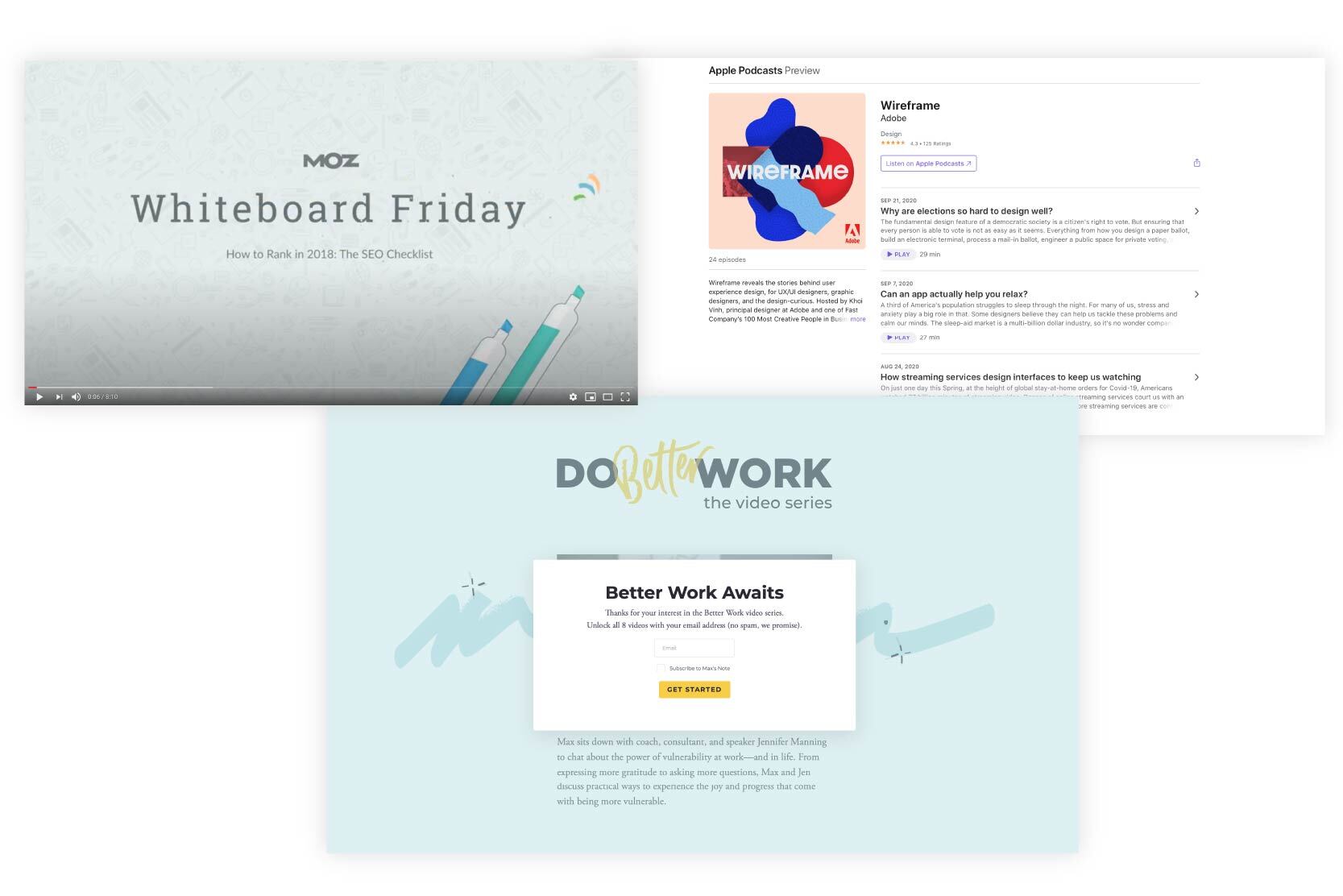
With in-person events paused for the foreseeable future, shows could fill part of the void in the marketing line-up. Like educational courses, video series are good for driving and nurturing leads. They’ve proven to be effective—a study from Animoto found that four times as many customers would rather watch a video than read an article to learn about a product.
One new show that Acunzo recommended is Onboarding Joei, created by 360Learning. The docu-series, which debuted in April, follows Joei Chan as she gets acclimated as the tech company’s new director of content.
As writer Molly Donovan detailed on the Marketing Showrunners blog, the show drove immediate results. In the past, 360Learning had to spend €900 to acquire a marketing qualified lead. For Onboarding Joei, the MQL cost dropped to €25.
“I was able to show that I could bring in a lot of qualified subscribers,” Nicolas Merlaud, the show’s creator, told Donovan. “Moreover, I could prove the show’s ROI.
This approach could even translate to virtual events. (There’s a reason they call it event “programming.”) Standard marketing events tend to struggle with meandering panels, awkward lulls, and dry speakers. Pre-recorded presentations benefit from higher production value, and polished editing grants audiences a smoother experience.
Recently, we adjusted our lead generation efforts to include pre-recorded webinars. The slides and voiceover were edited and uploaded before the event time. After the presentation, we switched to a live Q&A with attendees to address their thoughts.
The move makes a ton of sense because we’re showing the best possible version of our work. At the end of the day, whether you work for Netflix, Google, or a company just starting to invest in B2B content, that’s what we should all be aiming for.
How to take advantage of this trend:
- Brainstorm series instead of ad-hoc stories when planning your content calendar
- Invest in video content, budget permitting, to give customers a binge-worthy experience
- Explore turning in-person events into a virtual series with a mixture of pre-recorded and live elements
Get better at your job right now.
Read our monthly newsletter to master content marketing. It’s made for marketers, creators, and everyone in between.





